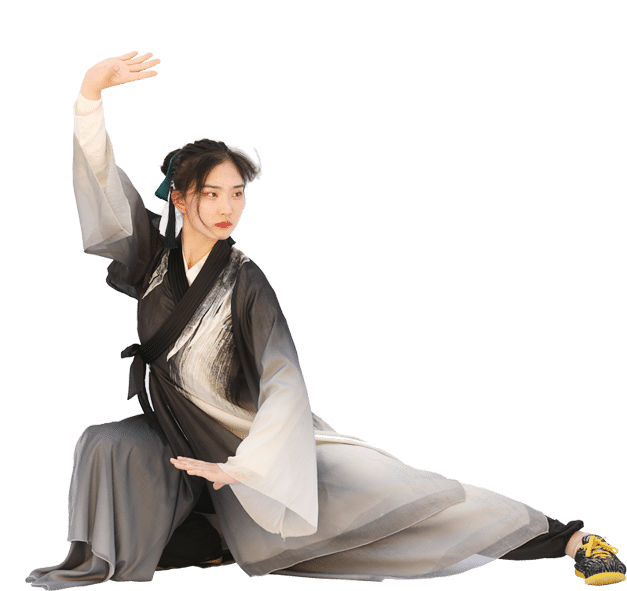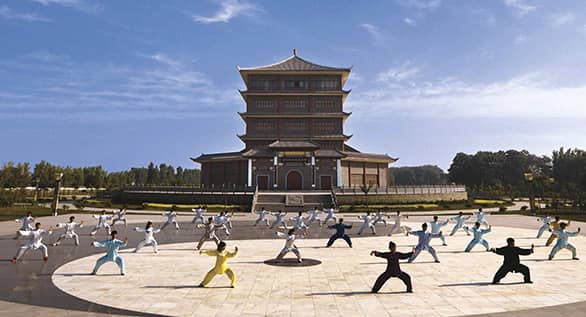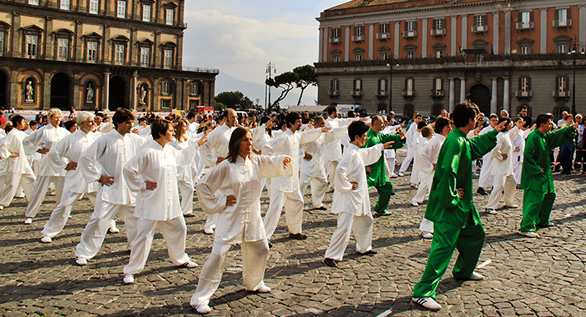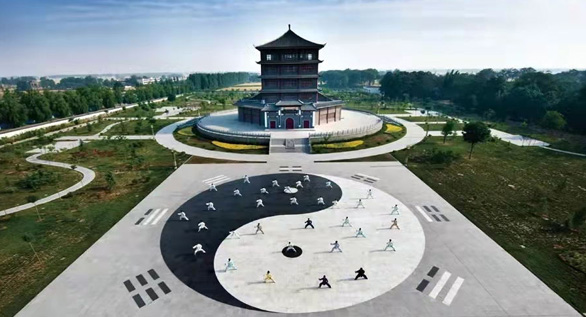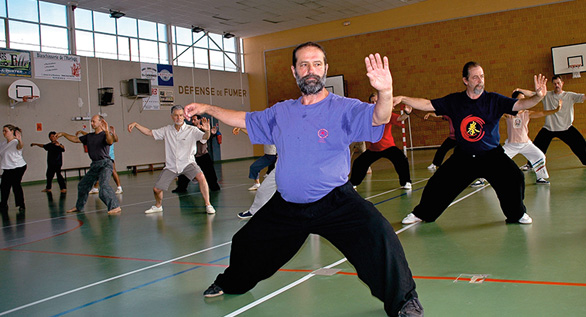Chen Wangting
Chen Wangting (c.1600-1680) was a native of Chen Jiagou village, Wen County, and the founder of Chen style Taiji Boxing. Based on his ancestral boxing techniques, he learned from various schools, combined meridian science and the Huangting Jing techniques of channeling and exhaling, and based on the principles of the Taiji diagram, he invented a new style of boxing—Taiji Boxing that is spiraling and twining, alternate fast and slow with a close coordination of ideas, breathing and movements, and a flexible response to technical attacks, which can overcome the rigid with softness and the strong with weakness.
Jiang Fa
Jiang Fa, also written as “Jiang Ba”, was born between the year of Chongzhen in the Ming Dynasty and Kangxi in the Qing Dynasty. He used to follow Li Jiyou to raise an army against the Ming Dynasty for heavy taxes and turning over food. After Li Jiyou surrendered to the Qing Dynasty and was killed, Jiang Fa joined the Chen Wangting as a servant. Well-known for his fast legs, it is said that Jiang Fa could walk as fast as a horse. One day, when he went to the Yellow River with Chen Wangting for rabbit hunting, Jiang Fa chased after a rabbit and caught it at less than 100 paces. Jiang Fa was a lifelong servant of Chen Wangting and gained the essence of his boxing style, making him famous for a while. The Chen Family Ancestral Hall used to have a portrait of Chen Wangting, with Jiang Fa standing next to him with a large sword. It is said that Jiang Fa was the master of Chen Changxing (1771-1853), but this is inconsistent with history record.
Chen Changxing
Chen Changxing (1771~1853), courtesy name as Yunting, was a master of the 14th generation of Chen style Taiji Boxing. Changxing learned Chen-style old form boxing from his father at an early age and practiced very hard at all times and in all places. Whenever he sat, his head and body are straight; whenever he walked, he meditated on his boxing techniques. Even holding a brush or a cup in his hand, he practiced the combination of strength. Therefore, when he practiced boxing, he moved in a dignified manner remaining his body upright. By the Daoguang period of the Qing Dynasty (1821~1850), his skills had become more refined and he was able to stand in the midst of a crowd without moving feet, despite being crowded by many people. Those who came close to him felt like water touching a stone, and would fall down without resistance. People of the time called Changxing “Mr. Tablet (Pai Wei)“. Chen Changxing was known as a bodyguard in Shandong and also well known in the Wushu world.
Chen Youben
Chen Youben (1780-1858), courtesy name as Daosheng, trained with his brother Youheng (courtesy name as Shaoji) from his father since childhood and became a master of Taiji Boxing. After his thirties and forties, he practiced boxing conscienciously, gaining a deeper understanding of the essence of Taiji Boxing, and boldly innovated. He gradually abandoned certain difficult and extremely powerful movements on the basis of the original Taiji Boxing routines, practiced with the same generous and spacious stance as the old form (big form) Taiji Boxing compiled by his peers, but softer and more natural, more elegant, inclusive, and powerful. It is also divided into Routine Ⅰand Routine Ⅱ boxing, later known as the “New form”. These achievements made him a famous coach of his generation in the history of Taiji Boxing. At that time, he had trained many skilled disciples of Taiji Boxing who became famous such as Chen Qingping, Chen Youlun, Chen Zhaozhao, Chen Sande and Chen Yundong. Among them, Chen Qingping is the most famous.
Chen Qingping
Chen Qingping (1795-1868) is the 15th generation of the Chen family and the 7th generation descendant of Chen style Taiji Boxing. In his childhood, he learned Taiji Boxing Xiaojia from Chen Youben. When he grew up, he became a famous practitioner and won the praise of Chen Changxing and Chen Youben. Due to his family‘s business needs, he moved to Zhaobao Town, which is eight miles away from his home. After moving to Zhaobao Town, in addition to running his business and practicing boxing, he spent his spare time to teach the ancestral Chen style Taiji Boxing to the village youth. After a long time, more and more people started to practice Taiji Boxing, so he opened a martial arts school in the town and officially taught apprentices, which was widely spread in Zhaobao Town. After returning to his hometown, he devoted himself to the study of Taiji Boxing and created his own style, which is today‘s Wu--style Taiji Boxing.
Chen Xin
Chen Xin (1894 ~ 1929), whose courtesy name is Pinsan, the 16th generation of the Chen family, was a Gongsheng (a name for excellent student in government examinations in ancient time) in the former Qing Dynasty. He was a famous Taiji Boxing theorist in the history of modern Chinese sports. He studied Wushu with his father since he was a child, and was familiar with the essence of Taiji martial arts. Later, he followed his father‘s instructions and studied the literature. He has achieved both literary and martial arts. In order to elucidate the theory of the Chen family‘s Taiji Boxing, he wrote books in his later years. His main works include five volumes of The Chen Family Genealogy, several volumes of An Yuxuan‘s Collection of Poems and Essays, three or four volumes of The Illustrations of Chen-Style‘s Taiji Boxing (previously known as Picture Handouts of Chen-style‘s Taiji Boxing), one volume of An Introduction to Taiji Boxing, and The Three Three Six Boxing Manual. Among them, The Illustrations of Chen-Style Taiji Boxing is his representative work.
Chen Fake
Chen Fake (1887-1957), whose courtesy name is Fusheng, is the 17th descendant of the Chen family in Chenjiagou, Wen County, Henan Province. His father, Yanxi, was good at Chen-style Laojia Taiji Boxing. Chen Fake practiced boxing with his father as a child, and worked very hard. He practiced boxing three times a day, and ten movements each time. He treated the past 20 years like a day, never slackening. In 1928, he was invited to Beijing to teach boxing, and he still practiced 20 times a day, so his Kung Fu were skillful and proficient. When pushing the hand, it combines drops, throws and hits. And it starts when you hold your hand, which shows the true colors of Chen Style Taiji Boxing. The poet Yang who was good at Wushu, Chang (Ji Zi), once wrote a poem: “Yang is respected by the seniors of Taiji in the capital, who is slow and gentle and good at winning. No expectation that Mr. Chen has a different style and powerful strength.“ There are many scholars who admire the Chen’s name, among which the famous ones are Xu Yusheng, Shen Jiazhen, Gu Liuxin, etc. Shen and Gu co-authored the book Chen-style Taiji Boxing, expounding the theory and techniques of Chen-style Boxing.
Chen Zhaopi
Chen Zhaopi (1893-1972), whose courtesy name is Jifu, was a native of Chenjiagou Village, Wen County, Jiaozuo City, Henan Province, and the 10th generation descendant of Chen-style Taiji Boxing. Representatives of his disciples include Chen Xiaowang, Chen Zhenglei, Wang Xi‘an, Zhu Tiancai, etc. Noble in character and tireless in teaching, he has made great contributions to the promotion of Chen -style Taiji Boxing, and is deeply admired by people from all walks of life at home and abroad. He is a master of Chen style Taiji Boxing who inherits the past and ushers in the future.Chen Zhaopi has profound theoretical attainments and accumulated decades of experience. He has written books such as A Collection of Chen-style Taiji Boxing, An Introduction to Taiji Boxing. The Illustrations of Chen-Style Taiji Boxing, Thirteen Chapters of Chen-style Taiji Boxing Theory and other books .
Chen Zhaoxu
Chen Zhaoxu, the 18th generation of the Chen family in Chenjiagou, is the second son of Chen fake, the 7th generation of the Chen family. His elder brother Zhaoguan died early in his childhood while his younger brother Zhaokui was famous. He is versatile with an elegant disposition, exceptional intelligence, fond of hunting and good at Hu Chang instrument and painting. Since childhood, he has practiced boxing for more than 30 times a day according to his family tradition. He once went to Beijing with his father to participate in various arts. His Kung Fu has reached a high level and ranks the best of his generation. The subtle aspects of his boxing are often praised by his peers. Later, he respected his father‘s order and returned to his hometown to manage his family affairs and business. He used to be a teacher in a civilian school and teach the children of the village for literacy. Unfortunately, due to the bad social environment of that age, he died young after being persecuted several times in turmoil and he failed to breed more students, which was a great loss to the boxing community in the village.
Chen Zhaokui
Chen Zhaokui is the 18th generation of the Chen family in Chenjiagou. In 1928, Chen Fake agreed to the invitation of Xu Yusheng and others to Beijing for boxing teaching. There were many scholars, and all the teachings were big forms. Chen Zhaokui, the youngest son of Chen Fake, was born in Chenjiagou on January 24, 1928. He started to learn boxing at the age of seven and got the family tradition of low-stance boxing taught by his father. Under the strict supervision of Chen Fake, Chen Zhaokui‘s techniques was already outstanding in his twenties. After Chen Fake‘s death, Zhaokui worked independently and practiced much harder so that his Kung Fu became thriving and perfect. His capture technique can be called a unique one in the world. It is soft, strong and unpredictable, making people defenseless. His pushing technique is also superb. He can use strength lightly and skillfully, brittly and powerfully.
Chen Liqing
In 1919, Chen Liqing was born in a Wushu family in Chenjiagou. Because she has won the true tradition of Chen style Taiji Boxing and practiced hard, she is well-known among his peers. After graduating from Kaifeng City, Chen Liqing started to teach in Luoyang, Gansu and Xi‘an, and finally settled in Xi‘an. Focusing much on the discovery and dissemination of Chen style Taiji Boxing, she kept practicing martial arts and recruited many disciples. She has learned from Shaanxi the long-lost banned Chen-style 108 Chang Boxing. In the “Cultural Revolution“, in order to prevent the loss of the boxing manual, she hand-printed 70 copies of the boxing manual and distributed it to her tribes and disciples. After decades of hard work, she became a master of Chen -style Taiji Boxing weapons. In 1979, the first National Wushu Observation and Exchange Conference was held in Nanning. It was occasionally in her sixties, Chen Liqing attended the conference at her own expense. The perofomance presented by her and her disciples were welcomed by tens of thousands of people, and their Taiji stunts shocked the Wushu circles. Three years later, in her retirement, Chen Liqing also attended the 2nd National Wushu Observation and Exchange Conference as a special representative, and won the first prize for her wonderful Chen style Taiji Boxing performance.

